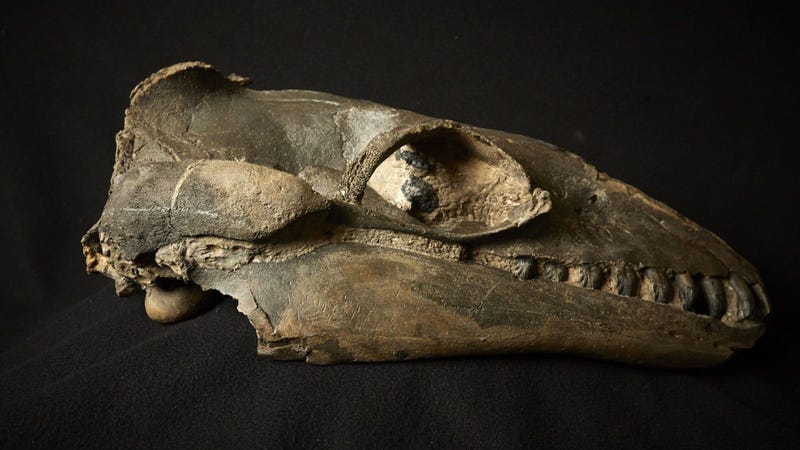 Fossilized ancient whale skull. (Image: Ben Healley/Museums Victoria)
Fossilized ancient whale skull. (Image: Ben Healley/Museums Victoria)
All living whales are descended from terrestrial mammals, but how these aquatic creatures evolved into giant filter-feeders remains a biological mystery. New research shows that ancient whales had razor-sharp teeth similar to land-based carnivores—an observation that’s upsetting a prevailing idea that ancient whales used their teeth for filter feeding.
Whales equipped with bristle-like baleen structures for filter feeding are the gentle giants of the sea, but as new research from Monash University and Museums Victoria points out, their ancestors were ferocious predators, featuring decidedly sharp teeth. This means that ancient whales likely never used their teeth for sifting seawater, and that some other evolutionary mechanism was responsible for the emergence of filter feeding behavior.
Today, whales are comprised of two main groups. You’ve got your filter feeding whales, also known as mysticeti, a group that includes humpbacks, fin whales, blue whales, and minke whales. And then you’ve got toothed whales, such as orcas. Filter feeding whales use their rows of baleen to filter plankton and small fish from the ocean, whereas orca whales use their teeth to chomp down on large prey, such as sea lions and other whales. Scientists have theorized that baleen evolved from teeth, but this latest research, published in Biology Letters, casts doubt on this line of thinking.
“Contrary to what many people thought, it seems that whales never used their teeth as a sieve, and instead evolved their signature filter feeding strategy only later—maybe after their teeth had already been lost,” noted study lead co-author Alistair Evans in a press release. “Our findings provide crucial new insights into how the biggest animals ever evolved their most important trait: filter feeding.”
For the study, Evans and his colleagues studied the 3D shape of fossilized teeth and modern teeth collected from museums in Australia and overseas. They compared the teeth of eight ancient whale species to four extant terrestrial animals—lions, coyotes, pumas, and dingoes—and five seals. As Evans explained, the size, orientation, and sharpness of teeth can tell us much about what an animal eats.
“Predators that kill and chew their prey need sharp teeth with cutting blades,” he said. “By contrast, species that use their teeth as a sieve have blunt teeth with rounded edges that help to filter prey from water. We found that ancient whales had sharp teeth similar to lions and dingoes so it likely they used their teeth to kill rather than filter.”
The study shows that the teeth of ancestral mysticeti whales were just as sharp as those of modern, land-dwelling carnivores and predatory seals, and that these animals were capable of both capturing and devouring prey with their teeth.
“Our results suggest that mysticetes never passed through a tooth-based filtration phase, and that the use of teeth and baleen in early whales was not functionally connected,” conclude the authors in their study. The “raptorial” composition of this ancient teeth (i.e. teeth used to grab and chomp-up large prey) highly preclude the possibility of these features evolving into the keratinous, comb-like filtering structure that now grows in the upper jaw of modern baleen whales, say the researchers.
So if the teeth of ancient mysticeti whales didn’t evolve into baleen, how did filter-feeding emerge? That’s still an open question, but there are at least two possibilities. First, it’s conceivable that baleen emerged alongside raptorial teeth, and that a period of overlap existed for a while until the filter-feeding strategy eventually won out. The other possibility is that ancient mysticeti evolved into suction feeders, triggering tooth loss and, eventually, a new evolutionary course that led to filter-feeding (on that point, recent research shows that an ancient offshoot of dwarf dolphins evolved into suction feeders).
More work clearly needs to be done in this area, but it would really help if paleontologists were to discover a “missing link” species of whale, showing what was going on in the mouths of these aquatic animals during this important transitionary time.
[Biology Letters]